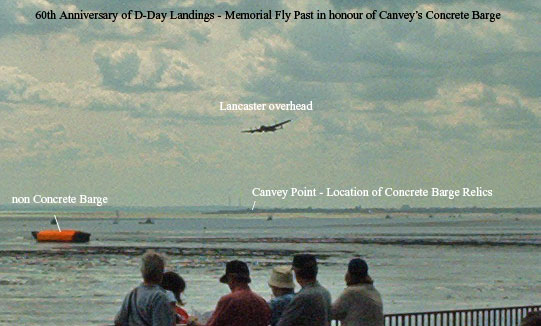
Concrete Barge Info: Part 1 - Canvey FCB

History of our Beloved Barge
gathered so far
Dave Bullock recalls "I was born on Canvey Island in the early 1960's and can remember as a small child first looking over the concrete crowned black sea wall at Canvey Point and seeing a strange boat made of concrete! I remember being told it was probably built by a failed inventor and had never floated - well who could believe a boat made of concrete could ever float?" As the years went on the general opinion was that she was part of the W.W.II Mulberry Harbour, another part of which is still off Southend-on-Sea to this very day.
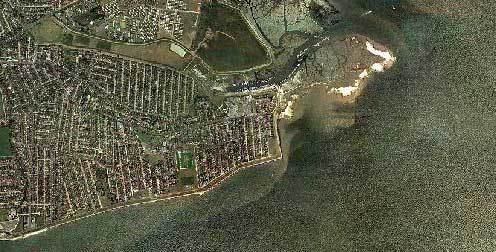
Canvey Island Essex - The Point
Whatever its history, as far as we were all concerned it was the most wonderful place to explore & play. We have had so many messages from people all over the world who have fond memories of climbing over the Barge and exploring inside. Some of the internal walls had doorways made at a later date - Remember the small forward hold being full of sand and the driest? If brave enough you had to balance along the spine towards the back to prevent getting 'a booty' (wet!)! When the tide was out the Barge was surrounded in shells & sand - as the tidal River Thames came in she was surrounded by the sea. The very last time we saw the Barge was summer 2002 when walking with friends as far as the South East point of Canvey and saw her in the distance - indeed we took a photo and you can see the pleasure on the faces the Barge brought to us.
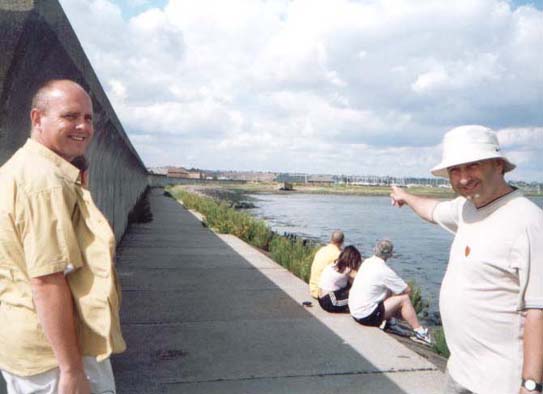
Steve & Kev - My last sight of the Barge in 2002
It was May 2003 when we recieved "guess what they've demolished now" phone calls from family. Surely not the Labworth cafe - no - they couldn't destroy it as they even had to build the new sea wall around it! The Lobster Smack perhaps? "Not the Concrete Barge?"... sickenly yes. On the Friday before the Bank holiday weekend the adjacent Yacht Club had destroyed the Barge. The reason given was that it was 'an eye sore' and a danger to the kids who played on it. We believe they did own the vessel (compare it with owning an animal - you are just its keeper!) but after much argument in the local press (see 'NEWS' section) the fact was she had gone. A visit to the site (see 'VISITS') resulted in the sad sight of a few remnants covered in a foul black clay and the decision to set up this website in her memory, and indeed in memory of all the Canvey landmarks that have disappeared over the last few decades.
Use your mouse to locate the Barge
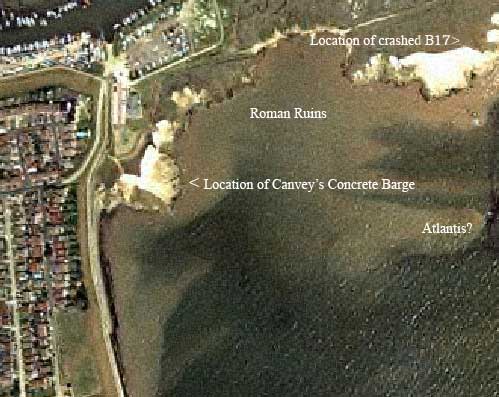
Closer look via Satellite - If you click on the exact spot the Barge was you
can see a closer view
So what is the history of
'our' Concrete Barge? They are known as Ferro Concrete Barges (FCB's). Local
folk law has it that it was part of the WW2 Mulberry Harbour. Len Barge explained
he believes it was a fuel barge in the D-Day convoys that broke away in the
bad weather (as did the Concrete Caisson that beached further down off Thorpe
Bay) and drifted to the Holehaven area. This theory is hinted at by local historian
Fred McCave who wrote in The Bulletin (Vol.3 No.11) on Sept 1982: "Nor
must we overlook the Concrete Barge there (The Point), part of the Normandy
invasion harbour of 1944. How that nearly threatened the Canvey sea wall there
in storm conditions.."
Another account is she was put at Canvey point to show the Germans the people
of Canvey meant business! Ian Hawks says it was moored at Hole Haven creek until
1951 when the Canoe Club bought it for £11 on the understanding they would
move it quickly. George Chambers of the Canoe Club takes up the story:
|
"Around 1952 the Canvey Island Canoe
Club felt that they needed a Club house & a gentleman who had undertaken
to dispose of a number of these barges agreed to sell us one for I think
around £15 pounds, towing it (See HERE)
to Canvey Point & mooring it close to & parallel with the
sea wall so that access could be made from the sea wall. Work started
by cutting a hole in the deck & building a brick entrance over it.
A hole or perhaps 2 were knocked in compartments so that in theory it
would not float. This proved to be wishful thinking as a high tide &
strong wind moved it so that it rested on the foot of the sea wall.
By then I had taken over as secretary & I received a strong letter from the appropriate authority to move it at once if not sooner, as there was no chance of it floating until the next high tides in the spring, that's where things stood until 31 Jan 53, when I woke up to the sound of rushing water. Looking out of the window the bungalow where were living in Rainbow Road appeared to be moving at about 8 Knots. As my late wife often said later my first words were 'There's a Flood that bloody barge has knocked a hole in the seawall' While sitting on the garage roof I had time to reflect that it would take a lifetime if not longer to pay for all the damages. The barge had moved itself further away from the wall & turned itself around so that the proposed entrance faced the Southend pier so we rather lost interest. In the mid 50's the Club faded away & later still Victor Vandersteen who had taken over again as Secretary managed to sell it to someone for a token amount, to absolve us from further responsibility. When we bought it there were heavy cables & very large reinforced rubber / neoprene pipes in the holds. There was no rudder, I don't think it was ever used, it was like new inside just dust from the cement." |
Here on the sea shore shells she sat safely, abandoned and left for the locals to adopt. All we can do here is collect the stories and present them for discussion. Where was she before 1951?
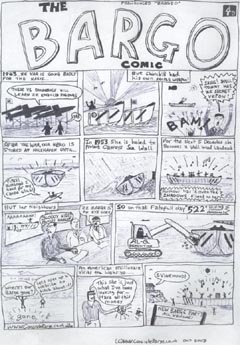
Click on Comic for a light hearted version of the history of
the Barge
Click Picture below for "History Part 2 - Concrete Barges"